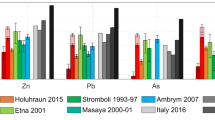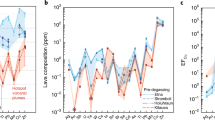Abstract
Volcanic emissions represent one of the most relevant natural sources of trace elements to the troposphere. Due to their potential toxicity, they may have important environmental impacts from local to global scale. They can also severely affect the atmospheric and terrestrial environment at timescales ranging from a few to millions of years. Mt. Etna volcano is known as one of the largest global contributors of magmatic gases (CO2, SO2 and halogens) and particulate matter, including some toxic trace elements. The aim of this study is to characterize the chemical composition and the mineralogical features of the volcanogenic aerosol passively emitted from Mt. Etna. Twenty-five samples were collected by filtration technique from different sites between 2008 and 2014. Chemical and mineralogical analyses allowed to discriminate two main constituents: the first is mainly referable to the silicate component in the volcanic plume, like lithic, juvenile fragments or glass shards and crystals (e.g. plagioclases, pyroxenes, oxides); the second constituent consists of soluble compounds like sulphosalts or halide minerals (sulphates, chlorides and fluorides). Fluxes of major and trace metals emitted in the atmosphere have been estimated. By comparing the Etnean trace elements with those from European anthropic emissions, we conclude that Mt. Etna is the main persistent point source of major and trace metals in the Mediterranean region. Results gathered from this investigation is of fundamental importance due to the exposure and potential impact of harmful chemical compounds for hundred thousand tourist visits each year to the summit of Mt. Etna.








Similar content being viewed by others
References
Aiuppa A, Federico C, Paonita A, Pecoraino G, Valenza M (2002) S, Cl and F degassing as an indicator of volcanic dynamics: the 2001 eruption of Mount Etna. Geophys Res Lett 29(11):15529. doi:10.1029/2002GL015032
Aiuppa A, Dongarrà G, Federico C, Pecoraino G, Valenza M (2003) Degassing of trace volatile metals during the 2001 eruption of Etna. In: Robock A, Oppenheimer C (eds) Volcanism and the Earth’s Atmosphere. Geophysical Monograph, p 139
Bonaccorso A, Caltabiano T, Currenti G, Del Negro C, Gambino S, Ganci T, Giammanco S, Greco F, Pistorio A, Salerno G, Spampinato S, Boschi E (2011) Dynamics of a lava fountain revealed by geophysical, geochemical and thermal satellite measurements: the case of 10 April 2011 Mt. Etna eruption. Geophys Res Lett 38:L24307. doi:10.1029/2011GL049637
Buat-Menard P, Arnord M (1978) The heavy metal chemistry of atmospheric particulate matter emitted by Mount Etna Volcano. Geophys Res Lett 5(4):245–248
Cadle RD (1980) Some effects of the emissions of explosive volcanoes on the stratosphere. J Geophys Res 85(C8):4495–4498
Calabrese S, D’Alessandro W (2015) Characterization of the Etna volcanic emissions through an active biomonitoring technique (moss-bags): part 2—Morphological and mineralogical features. Chemosphere 119:1456–1464
Calabrese S, Aiuppa A, Allard P, Bagnato E, Bellomo S, Brusca L, D’Alessandro W, Parello F (2011) Atmospheric sources and sinks of volcanogenic elements in a basaltic volcano (Etna, Italy). Geochim Cosmochim Acta 75:7401–7425
Calabrese S, D’Alessandro W, Bellomo S, Brusca L, Martin RS, Saiano F, Parello F (2015) Characterization of the Etna volcanic emissions through an active biomonitoring technique (moss-bags): part 1—major and trace element composition. Chemosphere 119:1447–1455
Caltabiano T, Burton M, Giammanco S, Allard P, Bruno N, Murè F, Romano R (2004) Volcanic gas emission from the summit craters and flanks of Mt. Etna, 1987–2000, in Mt. Etna: Volcano Laboratory, Geophys. Monogr. Ser., vol 143, (eds Calvari et al) pp. 111–128, AGU, Washington, D.C
Campion R, Salerno GG et al (2010) Measuring of volcano degassing of SO2 in the lower troposphere with ASTER band measurements. J Volcanol Geotherm Res 194:42–54
Erfurt-Cooper P, Cooper M (2010) Volcano and geothermal tourism. Earthscan, London, p 378
Floor GH, Calabrese S, Román-Ross G, Aiuppa A (2011) Selenium mobilization in soils due to volcanic derived acid rain: an example from Mt Etna volcano, Sicily. Chem Geol 289(3):235–244
Gauthier P-J, Le Cloarec M-F (1998) Variability of alkali and heavy metal fluxes released by Mt. Etna volcano, Sicily, between 1991 and 1995. J Volcanol Geotherm Res 81:311–326
Hinkley TK, Lamothe PJ, Wilson SA, Finnegan DL, Gerlach TM (1999) Metal emissions from Kilauea, and a suggested revision of the estimated worldwide metal output by quiescent degassing of volcanoes. Earth Planet Sci Lett 170:315–325
La Spina A, Burton M, Salerno GG (2010) Unravelling the processes controlling gas emissions from the central and northeast craters of Mt. Etna. J Volcanol Geotherm Res. doi:10.1016/j.jvolgeores.2010.09.018
Martin RS, Mather TA, Pyle DM, Watt SFL, Day J, Collins SJ, Wright TE, Aiuppa A, Calabrese S (2009) Sweet chestnut (Castanea sativa) leaves as a bio- indicator of volcanic gas, aerosol and ash deposition onto the flanks of Mt. Etna in 2005–2007. J Volcanol Geotherm Res 179:107–119. doi:10.1016/j.jvolgeores.2008.10.012
Merucci L, Burton M, Corradini S, Salerno GG (2011) Reconstruction of SO2 flux emission chronology from space-based measurements. J Volcanol Geotherm Res. doi:10.1016/j.jvolgeores.2011.07.002
Montana G, Randazzo L, Mazzoleni P (2012) Natural and anthropogenic sources of total suspended particulate and their contribution to the formation of black crusts on building stone materials of Catania (Sicily). Environ Earth Sci 67:1097–1110
Moune S, Gauthier P-J, Delmelle P (2010) Trace elements in the particulate phase of the plume of Masaya Volcano, Nicaragua. J Volcanol Geotherm Res 193(2010):232–244. doi:10.1016/j.jvolgeores.2010.04.004
Nriagu JO (1989) A global assessment of natural sources of atmospheric trace metals. Nature 338:47–49
Oppenheimer C (2003) Volcanic degassing. In: The crust (ed RL Rudnick) vol 3, Treatise on geochemistry (eds HD Holland & KK Turekian), Elsevier-Pergamon, Oxford, pp 123–166
Patanè D, Aiuppa A, Aloisi M, Behncke B, Cannata A, Coltelli M, Di Grazia G, Gambino S, Gurrieri S, Mattia M, Salerno G (2013) Insights into magma and fluid transfer at Mount Etna by a multi-parametric approach: a model of the events leading to the 2011 eruptive cycle. J Geophys Res Solid Earth 118:1–21. doi:10.1002/jgrb.50248
Salerno GG, Burton MR, Oppenheimer C, Caltabiano T, Tsanev V, Bruno N (2009a) Novel retrieval of volcanic SO2 abundance from ultraviolet spectra. J Volcanol Geotherm Res 181:141–153. doi:10.1016/j.jvolgeores.2009.01.009
Salerno GG, Burton M, Oppenheimer C, Caltabiano T, Randazzo D, Bruno N (2009b) Three-years of SO2 flux measurements of Mt. Etna using an automated UV scanner array: comparison with conventional traverses and uncertainties in flux retrieval. J Volcanol Geotherm Res 183:76–83. doi:10.1016/j.jvolgeores.2009.02.013
Spampinato L, Sciotto M, Cannata A, Cannavo F, La Spina A, Palano M, Salerno GG, Privitera E, Caltabiano T (2015) Multiparametric study of the February–April 2013 paroxysmal phase of Mt. Etna New South-East crater. Geochem Geophys Geosyst 16:1932–1949. doi:10.1002/2015GC005795
Tassi F, Capecchiacci F, Cabassi J, Calabrese S, Vaselli O, Rouwet D, Pecoraino G, Chiodini G (2012) Geogenic and atmospheric sources for VOCs (Volatile Organic Compounds) in fumarolic emissions from Mt. Etna and Vulcano Island (Sicily, Italy). J Geophys Res 117:D17305
Wang X, Boselli A, D’Avino L, Pisani G, Spinelli N, Amodeo A, Chaikovsky A et al (2008) Volcanic dust characterization by EARLINET during Etna’s eruptions in 2001–2002. Atmos Environ 42(5):893–905
Wittmer J, Bobrowski N, Liotta M, Giuffrida G, Calabrese S, Platt U (2014) Active alkaline traps to determine acidic-gas ratios in volcanic plumes: Sampling techniques and analytical methods. Geochem Geophys Geosyst 15. doi:10.1002/2013GC005133
Acknowledgments
Part of the data presented in this work was obtained during the “Mt. Etna-Pizzi Deneri field trips” of the years 2010–2014 organized and supported by the Università degli Studi di Palermo (DiSTeM) and the Istituto Nazionale di Geofisica e Vulcanologia (INGV) of Catania and Palermo.
Author information
Authors and Affiliations
Corresponding author
Additional information
This article is part of the Topical Collection on DUST
Rights and permissions
About this article
Cite this article
Calabrese, S., Randazzo, L., Daskalopoulou, K. et al. Mount Etna volcano (Italy) as a major “dust” point source in the Mediterranean area. Arab J Geosci 9, 219 (2016). https://doi.org/10.1007/s12517-015-2165-0
Received:
Accepted:
Published:
DOI: https://doi.org/10.1007/s12517-015-2165-0




